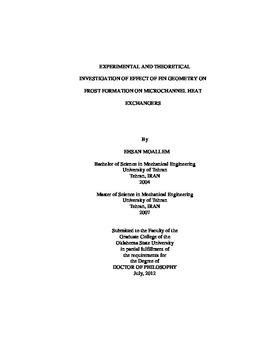| dc.contributor.advisor | Cremaschi, Lorenzo | |
| dc.contributor.author | Moallem, Ehsan | |
| dc.date.accessioned | 2013-12-10T18:05:20Z | |
| dc.date.available | 2013-12-10T18:05:20Z | |
| dc.date.issued | 2012-07 | |
| dc.identifier.uri | https://hdl.handle.net/11244/7809 | |
| dc.description.abstract | Scope and Method of Study: | |
| dc.description.abstract | The present work focused on different aspects of frost formation on louvered folded fins in microchannel heat exchangers used in air source heat pump systems. The approach taken was to perform laboratory experiments on small scale coils and sample fins that were cut out from commercially available heat exchangers and replicated their operating conditions in laboratory. More than 150 tests with different surface temperature, air velocity and air humidity were performed on 12 different microchannel fin samples; 7 fin samples had different geometry and 5 fin sample had identical geometry but with various surface coatings. The effects of surface temperature, fin geometries, surface coatings and environmental parameters were studied. Frost thickness and frost mass were measured. Air pressure drop across the coil, heat transfer rate and coefficients in form of Colburn j-factor during the frosting periods were measured. | |
| dc.description.abstract | Findings and Conclusions: | |
| dc.description.abstract | It was found that non-louvered low fin density sample had longer frost time (3.2 times) but lower capacity (-1.6 times) in comparison to louvered samples. Other geometrical parameters such as fin length (height) and fin depth had minor effect on frosting time and capacity per face area. Surface temperature had the highest impact on frosting time and capacity of all fin samples so that 6 degrees Celsius higher surface temperature resulted in around 1.8 times decrease in initial capacity but 3.3 times longer frost time. The tested hydrophilic coated sample resulted in slightly increased frost time (15%) in comparison to hydrophobic sample. This study broke new ground on developing a set of three correlations for frost thickness, air face velocity drop, and heat transfer coefficient of 7 fin geometries for microchannel heat exchangers. The developed correlations were able to predict the frost thickness, air face velocity degradation and dimensionless heat transfer Colburn j-factor within �17.6% and �7.7% and �16.7%. | |
| dc.format | application/pdf | |
| dc.format | application/vnd.ms-powerpoint | |
| dc.language | en_US | |
| dc.rights | Copyright is held by the author who has granted the Oklahoma State University Library the non-exclusive right to share this material in its institutional repository. Contact Digital Library Services at lib-dls@okstate.edu or 405-744-9161 for the permission policy on the use, reproduction or distribution of this material. | |
| dc.title | Experimental and theoretical investigation of effect of fin geometry on frost formation on microchannel heat exchangers | |
| dc.contributor.committeeMember | Fisher, Daniel E. | |
| dc.contributor.committeeMember | Spitler, Jeffrey D. | |
| dc.contributor.committeeMember | Johannes, A. J. | |
| osu.filename | Moallem_okstate_0664D_12255.pdf | |
| osu.accesstype | Open Access | |
| dc.type.genre | Dissertation | |
| dc.type.material | Text | |
| dc.type.material | Moving image | |
| dc.subject.keywords | frost | |
| dc.subject.keywords | geometry | |
| dc.subject.keywords | heat exchanger | |
| dc.subject.keywords | heat pump | |
| dc.subject.keywords | heat transfer coefficient | |
| dc.subject.keywords | microchannels | |
| thesis.degree.discipline | Mechanical Engineering | |
| thesis.degree.grantor | Oklahoma State University | |
